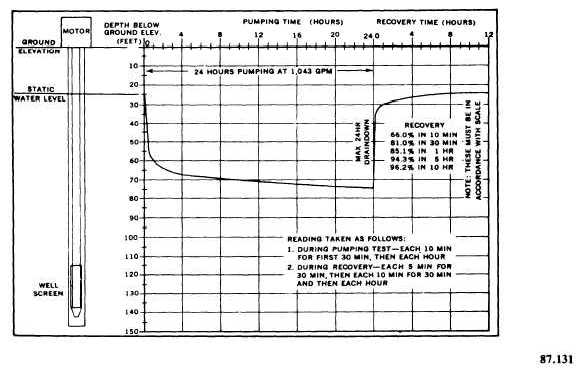directly proportional to the permeability of the formation. This property of the formation varies through wide ranges, the value for a coarse sand stratum being several hundred times that of a fine sand stratum of the same thickness. It increases with the coarseness of the sand and decreases with the compactness of the material. It increases where the sand grains are more nearly uniform in size. It decreases when fine sand and silt fill the voids between larger particles. The permeability of a rock formation, like limestone, varies with the number and sizes of the fractures, crevices, and solution channels.
The measurements that should be made in testing wells include the volume of water pumped per minute or per hour, the depth to the static water level before pumping is started, the depth to the pumping level at one or more constant rates of pumpage, the recovery of the water level after pumping is stopped, and the length of time the well is pumped at each rate during the testing procedure. The testing described in this chapter is essentially the measurement of the hydraulic characteristics of a particular well.
The pump and power unit used for testing a well should be capable of continuous operation at a constant and variable rate of pumpage for a period of over 24 hours. It is important that the equipment be in good condition for an accurate test, since it is undesirable to have a forced shutdown during the test. The test pump should be large enough to test to the expected capacity of the well, even though this may be far beyond the amount of water required and may exceed the capacity of the permanent well pump. Pumping by airlift maybe a practical method, provided that meters are not used for measuring the flow. The test should run at least 24 hours. Longer tests, up to several weeks' duration, may be desirable to verify adequacy of the formation.
To determine the safe yield of the well, the pump should be operated at a rate that will cause only about 50 percent of the maximum possible drawdown. The drawdown should not exceed a point 5 feet above the topmost screen slot. For example, a 125-foot well has a static water level of 25 feet and a pumping level of 75 feet or a 50-foot drawdown. The satisfactory pumping level is 50 feet or 50 percent of the maximum drawdown. Therefore, a safe well capacity is established and maintained for that condition regardless of the yield. The safe pumping yield is the withdrawal rate that will not cause a lowering of the water table, and should cause no more than 50 percent of maximum drawdown. A chart, similar to the one shown in figure 9-3, should be

Figure 9-3. - Well chart.
Continue Reading